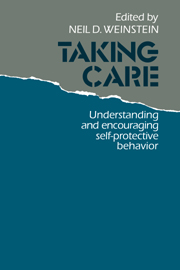Book contents
- Frontmatter
- Contents
- List of contributors
- Acknowledgments
- Introduction: studying self-protective behavior
- I Theoretical perspectives
- II Research and prevention programs for specific hazards
- 6 Why people take precautions against health risks
- 7 Community studies of smoking cessation
- 8 Preventing adolescent smoking
- 9 Natural hazards and precautionary behavior
- 10 Programs that encourage the adoption of precautions against natural hazards: review and evaluation
- 11 Why people take precautions against crime: a review of the literature on individual and collective responses to crime
- 12 Promoting citizen involvement in crime prevention and control
- 13 Injury prevention: limits to self-protective behavior
- 14 Perspectives on protective behaviors and work place hazards
- III Conclusion
- Index
7 - Community studies of smoking cessation
Published online by Cambridge University Press: 03 February 2010
- Frontmatter
- Contents
- List of contributors
- Acknowledgments
- Introduction: studying self-protective behavior
- I Theoretical perspectives
- II Research and prevention programs for specific hazards
- 6 Why people take precautions against health risks
- 7 Community studies of smoking cessation
- 8 Preventing adolescent smoking
- 9 Natural hazards and precautionary behavior
- 10 Programs that encourage the adoption of precautions against natural hazards: review and evaluation
- 11 Why people take precautions against crime: a review of the literature on individual and collective responses to crime
- 12 Promoting citizen involvement in crime prevention and control
- 13 Injury prevention: limits to self-protective behavior
- 14 Perspectives on protective behaviors and work place hazards
- III Conclusion
- Index
Summary
Community studies of smoking cessation refer to research in which geographically defined populations or age cohorts are selected for experimental intervention or as control or comparison groups. In this chapter, two major studies of cessation are described, and related research findings are briefly considered. The theoretical background for these studies is outlined, methodological issues are discussed, and directions for future research are suggested. It is concluded that community studies represent a significant emerging paradigm for public health research.
Characteristics of a controlled community study
For this discussion, a controlled community study is defined according to the scope of intervention and quality of research design, with the essential feature being the identification of natural, location-based aggregations of individuals as well as formal and informal social systems. In a community study, the entire population of a geographic area is considered, so that a church or worksite is not a community itself, but one of many systems constituting the total network of interactions.
Because the population size to be addressed is a limiting factor in any social program, the large numbers of people involved in a community study dictate selection of intervention methods. Clinical or other people-oriented approaches that typify behavioral research on smoking cessation and prevention (Bernstein, 1969; Bernstein & McAlister, 1976; Pechacek & McAlister, 1980; Lando & McGovern, 1982; Lichtenstein, 1982) are not feasible for programs directed toward many thousands of people. Community studies instead emphasize large-scale delivery systems such as the mass communication media.
- Type
- Chapter
- Information
- Taking CareUnderstanding and Encouraging Self-Protective Behavior, pp. 150 - 169Publisher: Cambridge University PressPrint publication year: 1987

